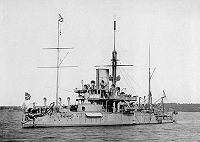Russian battleship Petr Velikyy (1872)
 Russian Ironclad battleshipPetr Velikiy | |
| Career | |
|---|---|
| Name: | Petr Velikiy, Peter the Great |
| Namesake: | Peter the Great |
| Operator: | Imperial Russian Navy |
| Builder: | Galerniy Island yard, St Petersburg |
| Laid down: | 1 June 1869 |
| Launched: | 27 August 1872 |
| Completed: | 14 October 1876 |
| Commissioned: | 1877 |
| Out of service: | 1919 |
| Fate: | Scrapped 1959 |
| General characteristics | |
| Displacement: |
9,665 tons (originally) 10,406 tons (after reconstruction) |
| Length: |
99.94 m (327.9 ft)(originally) 103.57 m (339.8 ft) (after reconstruction) |
| Beam: | 18.95 m (62.2 ft) |
| Draught: |
7.23 m (23.7 ft) (originally) 8.29 m (27.2 ft)(after reconstruction) |
| Propulsion: |
Original 12 coal fired rectangular boilers, 2 shaft HRCR steam engines. Replaced by 2 shaft VC steam engines and oval boilers, 8,258 hp |
| Speed: | 14 knots (26 km/h) |
| Complement: | 440 officers and crewmen |
| Armament: |
|
| Armour: |
Wrought iron belt 14 inch Citadel 14 inch Turret 14 inch |
The Petr Velikiy (Пётр Великий - Peter the Great) was a Russian ironclad turret battleship. The ship is considered by most authorities to be the first true battleship in the Imperial Russian Navy, all previous vessels either being predecessors of the cruiser type or more closely related to the monitor type of coast defence vessel.
The design was similar to HMS Devastation. She was built by the Galernii yard in St Petersburg. Laid down in June 1869, she was launched in 1872, and completed in 1877. She joined the Baltic Fleet in 1876. The original machinery proved unsatisfactory and was replaced in 1881 by Elder and Company in Glasgow, Scotland. She subsequently served in the Baltic Fleet. She was considered obsolete by 1905 and reconstructed as a training ship. She served in World War I, renamed Respublikanets (Republican) after the Russian Revolution, subsequently converted into a stationary depot ship and renamed ' 'Barrikada (Barricade) and finally scrapped in 1959.
Refit
She was fitted with Hughes compound armour comprising 22 inch of wood sandwiched between two 7 inch wrought iron plates. In service the horizontal compound engines gave considerable trouble and in 1881 she was given an extensive refit at Glasgow druing which she was re-engined with more powerful double expansion engines developing 5,500 hp. The rectangular boilers were removed and replaced by oval boilers. Although with more powerful engines, maximum speed in fact dropped by just over one knot to 12.9 knots.
During this refit the armament was modified, four 8.4 inch guns being added and the number of quick-firers reduced to thirteen. Two submerged 15 inch torpedo tubes were also added. The alternations led to an increase in displacement to 9,790 tons. In 1905 the ship underwent a major reconstruction to a gunnery training ship. During the conversion the upper deck and superstructure were completely altered. The number of masts was reduced to two and a new superstructure was built in front of the forward mast. The single funnel previously fitted was replaced by two funnels spaced forward and aft of the previous funnel's position. To equip the vessel for her gunnery training role the armament was completely altered, four 8 inch, six 6 inch, twelve 3 inch, four 57 mm, four 47 mm and two machine-guns being fitted. As a result of the reconstruction the length had increased to 339 ft 8 inch (oa) and draught to 27 ft 2 inch with a resulting increase in the displacement to 10,406 tons.
See also
 Media related to Battleship Petr Velikiy at Wikimedia Commons
Media related to Battleship Petr Velikiy at Wikimedia Commons
References
- Watts, Anthony J.,The Imperial Russian Navy, p. 30.
- Conway'sAll the World's Fighting Ships 1860-1905
- Article in Russian
- English article
de:Pjotr Weliki (1872) fr:Pierre le Grand (cuirassé) ja:ピョートル・ヴェリーキー (戦艦) ru:Пётр Великий (броненосец)
